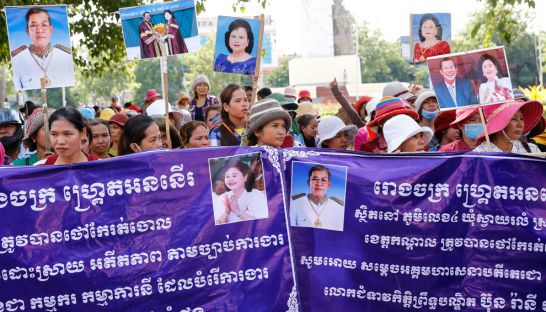Garment sector figures disputed
Garment sector figures disputed
Government officials and union groups yesterday cast doubts on the findings issued by the industry body for the nation’s garment and footwear manufacturers, challenging its claim that mounting investor concerns had forced dozens of local factories out of business and resulted in a sharp decline in garment and footwear orders.

Ly Tek Heng, operation manager at the Garment Manufacturers Association in Cambodia (GMAC), said on Monday that 70 garment factories had shut down so far this year with only 20 new factories opening – a sign he said that political uncertainty, labour unrest and a lack of competitiveness were eroding the Kingdom’s $6 billion garment industry.
Yesterday, GMAC secretary-general Ken Loo stood by those numbers, saying the findings were based on membership rates and that a representative survey showed that garment and footwear orders had declined by 20 to 30 per cent.
“We stand by our numbers,” he said, while acknowledging that GMAC does not actually keep track of import and export data, but relies on figures provided by the Ministry of Commerce and customs officials.
Loo said Cambodia’s garment sector – comprising over 1,000 factories and providing 600,000 jobs – had become uncompetitive compared to other developing countries, which led factory owners to shift their production bases.
“We have been saying for many years that Cambodia is not competitive and that companies will divest,” he said, noting that 2016 marked the largest membership contraction in GMAC’s 20-year history.
“There has been a decline in incoming investors, as well as our existing investors pulling out,” he said. “I believe this is a trend that will continue for the rest of the year.”
William Conklin, country director of the NGO Solidarity Centre, said yesterday it was very difficult to take GMAC’s findings as authoritative without the industry body supplying more data.
“It is very difficult to say if GMAC’s numbers are correct,” he said. “If this many factories did shut down, the question is how many jobs have been lost and how many have been gained?”
When asked about the number of jobs lost to the 70 factories shutting down, Loo said “we don’t keep track of that data.”
He was also unable to provide the names or of any of the shuttered factories, or indicate whether they were operating on seasonal contracts or as sub-contractors.
Soeng Sophary, spokesperson for the Ministry of Commerce, said she was not aware of any government report indicating the number of garment factories closed or opened since the start of the year.
She said while it was too early to discredit GMAC’s findings, it was likely that any recent closures would have involved small-scale factories, which would have little impact on the industry as a whole.
Nevertheless, she said half-year import and export figures gathered from the customs and excise department, verified by CAMCONTROL and then vetted by the Ministry of Commerce, would help paint a better picture. However, those figures have not been fully compiled yet.
Meanwhile, data from CAMCONTROL appears to contradict GMAC’s claim that garment and footwear orders had fallen by up to 30 per cent this year. The data show exports from garment factories reached $3.46 million during the first six months of 2016, a 4 per cent increase compared to the same period a year earlier.
Last week, Labour Minister Ith Samheng took to Facebook to waylay concerns over the perceived growth in factory closures by stating that only one had officially shut down – a number that union groups said was suspiciously low.
Far Saly, president of the National Trade Union Coalition (NTUC), yesterday said that while the number of factories shutting down has increased this year – to an estimated 30 – he doubted GMAC’s findings and overall decrease in orders. According to him, factory closures are typically seen as way to rebrand facilities.
“I have seen many cases where the factory closes and then is opened again by the same employers,” he said.
Conklin said GMAC’s findings lacked context and questioned the timing of their release, which comes as national minimum wage talks move into a final round of negotiations.
“GMAC is very selective in the data they choose,” he said.
“They should give a more in-depth analysis because the timing of these announcements always comes ahead of the minimum wage negotiations.”













